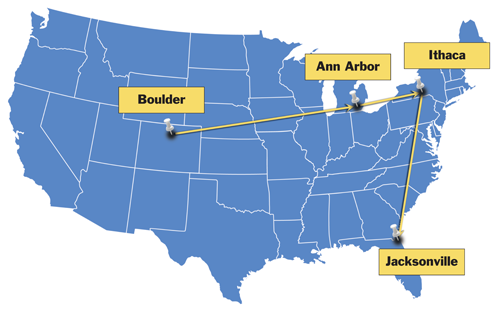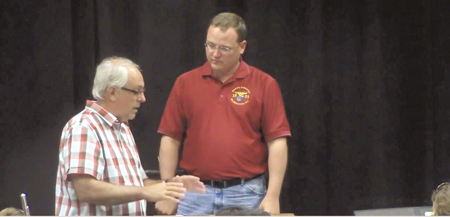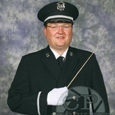
For many years I have stood in front of bands and thought little about the effect that my physical motions could have on the musicians. My main concerns were keeping the pulse and helping with tempi and rhythmic transitions. My facial and bodily gestures were plain and utilitarian. My arms waved, and I diligently took in the sounds from the ensemble while assessing what changes were needed. Then I stopped and told the group what I wanted from them. Although there are still times when this is an effective strategy, conductors should strive to show in our face, eyes, body, and entire being how we want the music to sound. Showing what we want, rather than telling, can save rehearsal time.
This was a foreign concept to me until I began my masters degree studies in conducting at Appalachian State University. My professor at the time, John Ross, encouraged me to attend one of the many conducting symposiums offered throughout the country with top wind conductors. I was scared. I assumed that these symposiums were reserved for the top conductors in our profession. I worried that I could not work with Jerry Junkin, Kevin Sedatole, Don McKinney, and others without making a fool of myself. After biting the bullet and attending four symposiums, I quickly realized that my fears were unfounded. I discovered that I truly can produce meaningful change within an ensemble without using words.
University of Colorado-Boulder
(June 7-12, 2015)
My first symposium was at the University of Colorado in Boulder. The guest clinician was Jerry Junkin from the University of Texas at Austin, as well as the conducting faculty at Boulder (Donald McKinney, Matthew Roeder, and Matthew Dockendorf). There were twenty conducting participants in attendance. The evening I arrived we all met with the clinicians and introduced ourselves. We then talked about the coming week.
I quickly noticed that the participants came from highly varied backgrounds. I assumed I would be amongst doctoral conducting candidates and other conductors with far more experience than I. Although there were some in that category, many came from backgrounds similar to my own. The large majority of the attendees were from public school teaching positions. Some were also currently attending graduate school at the master’s level. A couple were working on their doctorates or teaching at a college or university. I was happy to find out that I was not the most inexperienced conductor in attendance.
Feeling relieved by our introductions on the first evening, I proceeded into the first full day of the symposium with excitement but still a fear of what was to come. The first full day included conducting the chamber winds in the morning on a movement of Mozart’s Serenade in C Minor, KV 388(384a) or Old Wine in New Bottles by Gordon Jacob. Coming from a military band and high school band directing background, chamber winds were something foreign and frightening to me. In fact, I had never conducted such a group.
I arrived early at the rehearsal facility and grabbed a chair to do some final score study. Throughout the next twenty or so minutes all of the participants and clinicians arrived, and we had some time to chat. I was put at ease by the opportunity to speak with my fellow conducting participants. Each had a welcoming demeanor, and many shared the same apprehensions that I felt. We were all in this together.
Then we began the conducting sequence of the morning. Each participant had approximately 15 minutes in which to conduct their selected piece. As the first few participants proceeded to conduct, I felt a roller coaster of emotions, ranging from relief that we had begun to fear from knowing that I would soon be on the podium. After the first few conductors, this changed to a sense of excitement and comfort.
Each time someone finished many of us would have praise. Many times over the morning we had short breaks, during which we would congregate in the area outside the rehearsal hall and congratulate each other. The excitement was contagious, and it was evident that we were learning a tremendous amount from the clinicians and each other.
Then it was my turn. I stepped on the podium and introduced myself to the ensemble. My piece for this session was the Mozart. I raised my arms and we began. The first downbeat was exhilarating. The ensemble was primarily doctoral performance candidates, and it was evident they were great musicians. As we proceeded through the music all of the emotions from before came to the surface, but after only a few bars, they melted away and what was left was an amazing experience of music making.
On this first day the clinicians wanted to let us go for a couple minutes to create some comfort and allow an assessment of our abilities. After performing the entire exposition of the opening movement, Jerry Junkin stopped me to discuss some things. This felt otherworldly to me; I had been listening to recordings of the Dallas Wind Symphony directed by Junkin since I was a high school trombonist. The first encounter from the podium was wonderful. Junkin addressed both musical and technical concerns in my conducting. He had me try short sections using different interpretations and gestures to get the ensemble to play differently. Many times he whispered various suggestions to try with the group. This was a hugely telling experience because the ensemble had no idea what we would change each time. It was up to them to play exactly what they saw in my conducting. After each stop Professor Junkin had me conduct a section again with different gestures to show me how my movements affected the group. It was amazing how much non-verbal gestures changed the way the musicians played and sounded. After fifteen minutes, I was hooked. I couldn’t wait until my next opportunity to conduct. This had been one of the best musical experiences in my life.
The afternoon session consisted of a lecture with Donald McKinney, the director of bands at CU-Boulder. He explored several techniques of score study, using Rest by Frank Ticheli as the example work. We spent two and a half hours delving into the way that not only McKinney learned about musical scores, but also techniques that each of the other clinicians and conducting participants used.
The following days in Colorado were similar to the first. We met each morning and conducted chamber music. In the afternoons we had lectures and round table discussions with all of the clinicians. Two of the afternoons consisted of full band sessions on repertoire such as Lincolnshire Posy and Rest. These were exhilarating because of the chance to work with the clinicians in front of a large ensemble similar to our groups back at home. The ensemble members were mostly undergraduates students at CU-Boulder. They were all warm and welcoming and made us each feel as though this was our own high school or college ensemble from home.
One of the wonderful things about this experience was also that each time we conducted, our session was recorded for us to watch later. Also, each time we conducted the clinicians rotated, so we worked with each one directly throughout the week. One would work directly with us in front of the group while a second made comments onto the video recording of our session. Afterwards we met with a third person to view our recording and make more notes on different aspects we could improve and also areas that had gone particularly well. All of the clinicians were quite positive throughout our time together.
At the end of a wonderful week, the participants and clinicians met for our final morning of conducting. We each chose our favorite chamber work from earlier in the week to conduct, and had one last amazing experience in front of the ensemble. Afterwards there were hugs, information exchanges, pictures taken, and Facebook friend requests to remember all of the new connections we had made. Each of us wanted to stay longer and continue to learn in such a warm and wonderful environment.
Each of the following symposiums I attended had a similar daily schedule with a chamber winds and full ensemble portion as well as lectures. We usually conducted in the morning and had lectures or full ensemble conducting in the afternoon. All of them also included individual videos of our conducting sessions.
University of Michigan
(June 21-27, 2015)
My next symposium was at the University of Michigan with Michael Haithcock, John Pasquale, and Courtney Snyder. Professor Haithcock had also arranged for Jerry Schwiebert to join us for the week. Schwiebert teaches at the University of Michigan and is a body movement specialist who primarily teaches acting. Many of the techniques that he uses to help actors feel and look natural while acting also apply to conducting.

One difference at Michigan compared with the week at Colorado was that the majority of the conducting occurred with a large ensemble. We chose repertoire from all from the standard works from grades 3 to 6. Each time we conducted, one of the clinicians worked with us while we were on the podium. Then we spent about fifteen minutes outside the hall talking with another clinician about what occurred. We were also encouraged to sit in the ensemble and play. This created a fascinating opportunity to see the interaction each conductor had with the clinicians, as well as the change that occurred in our playing as the conductors altered their conducting technique.
The environment at the Michigan symposium was just as warm and welcoming as in Colorado. We had considerable time to make friends and speak with the clinicians outside of class time on any topic we liked. At the end of the week the graduate assistants from the university bands had arranged for a wonderful picnic for us all to attend to have one last chance to socialize before we returned home.
Ithaca College
(June 29-July 3, 2015)
I was excited to leave for Ithaca. After two symposiums I was no longer scared. I knew that this week would prove just as inspiring as the previous two. The clinicians for the week in Ithaca would be Kevin Sedatole from Michigan State University, as well as Stephen Peterson, who was leaving Ithaca College for the University of Illinois.
The week consisted primarily of full ensemble conducting along with one afternoon of chamber winds. During the afternoons that we were not conducting, we had lectures with the clinicians. One of the wonderful things at Ithaca was that the lecture sessions were previously planned, but also flexible enough to accommodate any desires of the conducting participants. Each afternoon Peterson allowed the planned conversation to take many twists and turns. This allowed us to get to know the clinicians and hear some wonderful stories. One afternoon Sedatole recalled the time he spent with Frederick Fennell. Another afternoon Peterson spoke to us about many of his teaching experiences throughout the years. Both clinicians discussed graduate school, public school and college teaching, concert planning, repertoire choice, and other aspects of being a band director. On the final day we all met and hiked together to visit some of the amazing waterfalls and scenic spots in the Finger Lakes region near Ithaca.
This week I took my entire family with me because we planned to go on vacation afterwards. For the entire week my wife, our five boys, and I camped in our pop-up camper close to Ithaca. I spent the days at the symposium and came home each evening to my family at our campground near beautiful Cayuga Lake. During the hike on the final day, my wife and boys came along and met all of my wonderful new friends and the world renowned conductors who taught us.
It was so amazing to connect with these talented people in my profession, but they also were very warm and kind in meeting my family. It truly made me feel as though the profession was a wonderful extended family where all are eager to help other succeed. After the week in Ithaca I continued to correspond with Sedatole numerous times while he watched my concert and rehearsal footage from the fall semester. Again, this demonstrated that our profession is one of collaboration and helpfulness.
University of North Florida
(September 19-20, 2015)
The final symposium I attended this year was at the University of North Florida. This opportunity happened after my fall semester began. I received a notice through the College Band Directors National Association website that Eugene Migliaro Corporon from the University of North Texas would be the guest. Corporon, along with Gordon Brock, director of bands at UNF, would be the clinicians for this symposium. The UNF symposium lasted only two days, but the schedule was similar to the other clinics I attended. We conducted in the morning and had lectures during the afternoon. The first evening in Florida, Gordon Brock invited us all to his home for an evening of socializing. It was nice to sit in his living room and speak with him and Corporon. Such a welcoming environment relieved any nervous tension. For decades I had also listened to recordings of ensembles under the baton of Professor Corporon. Now I was sitting beside him and chatting as if we had known each other for many years. The experience I had at UNF was just like all of the symposiums I had previously attended. The environment was positive, welcoming, and comfortable.
These four symposiums opened my eyes to the world of learning and music that we are surrounded by in our profession. I was able to push myself to become a better musician and conductor. In addition, I had the opportunity to meet many of the most highly regarded conductors in the band profession. Along with them, my fellow participants aided in creating an environment at each location that was amazing. I made friends that I have continued to stay in contact with over the past year and look forward to remaining in contact with throughout my career. I recommend that conductors of all ages, experience, and abilities attend such a symposium. It is an experience from which attendees will become better teachers for their students at home.






